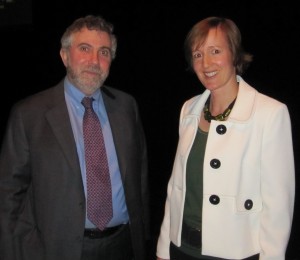
Nov 13, 2009 | Celebrities, Green jobs, Policy, Silicon Valley Events, Transcripts
By Alison van Diggelen, host of Fresh Dialogues
This exclusive interview with Paul Krugman was recorded on November 12, 2009 in SiliconValley. Dr. Krugman was in town to deliver a lecture as part of the Foothill College Celebrity Forum Series. Here are some transcript highights. To listen to the interview click here and or watch video.
Alison van Diggelen: Paul thank you very much for joining me on Fresh Dialogues.
Paul Krugman: OK. Good to be doing this.
Alison: Last night, you talked in your lecture of your concern about the unemployment rate. It’s very high and moving higher. In light of Obama’s announcement today about the job summit in DC in December, do you have any advice specific advice for Obama administration, particularly for green jobs?
Paul: Well OK, green jobs I think is going to be a much harder thing to get going. That’s going to take time. That really waits on climate legislation which we won’t get till next year, if we’re lucky.
What he needs to do is get some actual targeted job measures, we need some policies that are aimed at encouraging job creation directly: probably a job tax credit and maybe some subsidies for firms that hang on to jobs. We can learn a little bit from European countries (like) Germany which have been relatively successful in containing the job losses…We just have to get something going…. If I had my druthers, if there were no limits politically, I’d say actually let’s just have a really massive second stimulus plan to get the economy going, but since that’s not going to happen we need some measures that are cheaper, don’t maybe do as much for GDP but create a lot of jobs…
Alison: You said last night he’s been too cautious, Obama has been doing things in half measures. What advice would you give him at this stage?
Paul: This jobs summit can’t be an empty exercise…he can’t come out with a proposal for $10 or $20 Billion of stuff because people will view that as a joke. There has to be a significant job proposal…
Alison: Do you have a minimum he aught to spend?
Paul: There’s no hard and fast number, but if it isn’t several hundred billion dollars…OK, probably it’s not going to be as big as the first stimulus bill and not going to be as big as I think it should be… But I have in mind something like $300 Billion, you could do quite a lot that’s actually targeted on jobs.
Alison: Paul Krugman, thank you very much I really appreciate your taking the time.
Paul: Thank you so much.
Check back soon for more interview segments in which Paul Krugman discusses China, Climate Change and clean technology, the stimulus package, and why he prefers cap and trade over a straight carbon tax. He also explains what gave him that “missionary zeal” to write such fervent columns in the New York Times. To check out more exclusive Fresh Dialogues interviews, click here
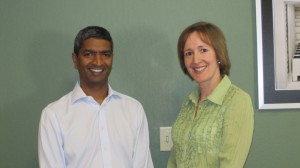
Nov 10, 2009 | Entrepreneurship & Innovation, Fuel Cells, Green World, Technology, Transcripts
By Alison van Diggelen, host of Fresh Dialogues
This is a transcript of Part Two of my interview with Bloom Energy CEO, KR Sridhar. The interview was recorded on September 30, 2009 at the Bloom Energy headquarters in Silicon Valley, California. To listen to the interview and read the original post, click here.
SEE THE VIDEO INTERVIEW WITH KR SRIDHAR HERE – A FRESH DIALOGUES EXCLUSIVE Part One: Fuel Cell Technology and Efficiency
Also Part Two Bloom Energy: Affordability is Essential Video
Part Three Bloom Energy: Mission to Change the World Video
To listen to Part One of the interview, click here, or read the transcript
We join the conversation as we are discussing the pricing of the Bloom Box.
Alison van Diggelen: KR, thank you for joining me today on Fresh Dialogues.
KR Sridhar: You’re welcome.
Alison: I appreciate your taking the time. So let’s talk about how affordable it (the Bloom Box) might be…I’ve read that $10,000 is a target…
KR: Don’t use any numbers.
Alison: Is this all speculation?
KR: That’s all speculation. So all that I can simply tell you is: if it needs mass market adoption, it needs to be affordable. And affordability is already set in the marketplace because today you buy electrons and you pay a certain price. If I offer you all the advantages of the kind of device I’m talking about, and you have to pay the same price you’re paying your local utility, then it’s affordable to you. So that goal is there. Our goal is clearly to make it affordable; if it’s not affordable, it’ll be the niche market, it’ll be a Tesla…
Alison: Right. And your goal is to make it absolutely affordable?
KR: We need it to be a Honda Civic.
Alison: A Honda Civic? I like that analogy. That’s great. Let’s talk about barriers to entry. You’re notoriously in stealth mode. Are there high barriers to entry to this? How many Ph.D.s do you have working on it?
KR: Absolutely – very high barriers to entry. The high barriers to entry come (from) – it’s a very complex interdisciplinary field; it requires knowledge not just in one area, in a significant number of engineering, science, material science disciplines…and the development of all the technology, the process know-how is fairly complex…and a significant amount of capital – and I can’t give you the number – that needs to be invested over a long period of time, to get it to where it needs to be. Those become the barriers to entry. But clearly, it’s a huge enough market that other people will try.
Alison: And how many Ph.D.s do you have on your team, working on this problem?
KR: Let’s say it’s in the hundred range.
Alison: It’s in the hundred? And I assume, this being Silicon Valley, people from around the world.
KR: Around the world.
Alison: You’re getting the best talent on this problem and they’re presumably all sworn to secrecy…
KR: They’re the best in what they do and that’s why they’re here.
Alison: You filed your first patent in 2003 and I understand there was one filed last year?
KR: Mmm-hmm.
Alison: Can you describe the trends from 2003 to now? You’re obviously a very patient man and you’ve talked about your motivations, but can you talk about the whole trajectory? In 2003, when you filed that patent, did you think that by September 2009, you’d be in production?
KR: We’d roughly laid out this timeline in our very first series of fundraising from our investors. For a project of this timescale, we’re probably within two, three quarters of the original projection…and again you need to understand that this is the kind of product that nobody has built before and an industry to support it doesn’t exist…So we’re not just building a company, we’re building all the support infrastructure that needs to be around us. So, given that caveat, if you accept that as the give-or-take, we’re on plan.
Alison: So there must be growing enthusiasm and excitement in this building?
KR: Absolutely. The big thing is the entire Bloom Team, from employees, to investors to board members to everybody else, are real believers in what we do and real believers in the mission of the company. So that alone creates the enthusiasm.
Alison: I bet. You’ve said ‘we want our products to speak before we speak.’ What do you mean by that?
KR: There’s been enough hype of people coming and saying ‘this is what we will do’ …a lot of them have not come to fruition…That doesn’t mean that they did something wrong. It’s just a very difficult problem to solve or somebody would have solved this a long time ago. And for us, we just didn’t want to add to that hype of coming and saying, ‘this is what it’ll do.’
We first wanted to be sure it works…It’s not just that it works, it can be made affordable. It can make a difference. You’re creating a business, you’re creating an industry, so it needs to work, it needs to be a quality product that has reliability, that people will buy. It needs to be the kind of product that makes a difference in somebody’s life to want to buy it. It can be…affordable – there’s a value proposition to it – and at that affordability rate, the business can be successful because it’s making a profit.
Alison: Well KR Sridhar, it’s been a pleasure. Thank you for joining me today on Fresh Dialogues.
KR: Thank you.
For more Fresh Dialogues with KR Sridhar, click here
For more Fresh Dialogues with Venture Capitalist, Vinod Khosla, click here
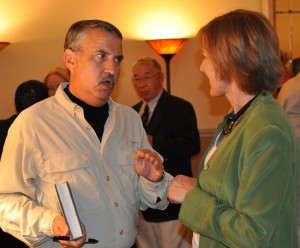
Oct 23, 2009 | Celebrities, Green World, Technology, Transcripts
By Alison van Diggelen, host of Fresh Dialogues
This is a transcript of my interview with Tom Friedman, recorded on September 10, 2009 at the Foothill College Celebrity Forum Series, in Silicon Valley.
Check out exclusive Fresh Dialogues Videos:
Tom Friedman on Copenhagen “This is a problem that will be solved by innovators, not regulators.”
Tom Friedman on his Envy of China’s action on Clean Energy: “You detect the envy of someone who wants his own government to act democratically with the same effectiveness that China can do autocratically.”
Introduction: In this second part of my interview with Pulitzer prize winning columnist, Tom Friedman, we discuss how he uses his platform to drive forward the green agenda. Tom shares his views on the resignation of Obama’s green czar, Van Jones, and how he himself deals with critics.
Alison van Diggelen: Tom, thank you very much for joining me today on Fresh Dialogues. In Davos this year, you asked: ‘Am I a bad guy for wanting to be China for a day?’ In light of the resignation of Van Jones, do you feel you’re a bad guy?
Tom Friedman: (laughter) No. I don’t feel Van Jones is a bad guy either.
Alison: Absolutely, but in that environment of criticism (that Van Jones bowed to), do you feel you are a ‘bad guy’?
Tom Friedman: I don’t really care. I say what I say. I think there’s a big audience for what I say and I don’t really pay attention to the critics.
Alison: Right. So you just turn a deaf ear?
Tom: I keep on marching on. I hear it and it’s fine. And it’s a free country. You can say whatever you want. But I’ve got my own bully pulpit and I use it. I don’t use it to shout back at critics; I use it to get my message out. I’m looking forward. You know, the dogs bark and the caravan moves on. I’m in the caravan.
Alison: But you don’t feel that distraction…that Glenn Beck and his ilk… are getting stronger and are going to be energized by the Van Jones resignation?
Tom: Well here I am giving a talk at De Anza College. We had 2500 people last night, 2500 tonight, 2500 people tomorrow night, actually paying money to come hear this and other lectures – not only my own. You were here last night…I think the audience was really paying attention, really motivated. Did everyone agree with every word I had to say? God, I hope not, that wouldn’t be a very interesting audience. But I think people understand the stakes, they’re living it every day. They know the climate’s changing and the Glenn Becks and the other opponents of these ideas will have their audience and I have mine…and let the best man win. To me that’s what it’s all about.
I don’t spend my time dealing with my critics. I’ve got a great podium and if you’re criticizing me, God bless you. I’m not above criticism. My focus is on my ideas with my audience.
Alison: I’m not intending to criticize you. But I’m just curious…
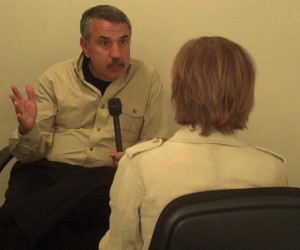 Tom: No, I’m telling you this is just my philosophy…I think you’d have to Google a long long time to find a column…I dare say, you’d have to Google forever to find a column where I’ve actually addressed personally, one of my critics.
Tom: No, I’m telling you this is just my philosophy…I think you’d have to Google a long long time to find a column…I dare say, you’d have to Google forever to find a column where I’ve actually addressed personally, one of my critics.
Alison: Good for you.
Tom: My feeling is, I’m out there. And therefore, if you can’t take the heat, don’t be out there, number one… But why would I waste a column writing about one of my critics when I can write about these really interesting ideas for my audience who cares. So what I always say to the critics is, ‘you may be writing about me, I really appreciate that, but don’t think for a second that I’d waste a column on you.’
Alison: Good for you. I like that.
Tom: I’ve got this platform in the New York Times, why would I waste it on one of my critics? By the way, they’re entitled to their criticism. I’m out there. Sometimes you even learn from critics, but you move on.
Alison: Talking about journalism, what is your feeling on the future of journalism? What is morale like at the NYT today?
Tom: Well, I think it’s getting better. I think there’s a feeling -hopefully, we keep our fingers crossed- that we’ve hit bottom. Stocks are creeping up. We’ve just announced that we’re going to start a pilot project here in San Francisco Bay Area, whereby every Friday and Sunday, there’ll be two local pages in the NYT of San Francisco news. We’re going to go after some of the papers out here and try to win readers here. We’re pushing forward, ideas are coming out…
Alison: Is that going to change your column at all?
Tom: No…no…em
Alison: It’s more local news?
Tom: They’re going to be writing about Bay Area news…
Alison: Right….I met with your colleague from the NYT, Maureen Dowd this year…
Tom: Uh huh.
Alison: And she told me that you guys get together for a daiquiri from time to time. She said, and I quote ‘when Tom is feeling down about climate change’…
Tom: (laughter)
Alison: So I’m curious to know how the daiquiris are going? Have there been a lot of daiquiris recently? In other words, are you feeling more optimistic or less optimistic since you wrote this book (Hot, Flat, and Crowded), Tom?
Tom: Umm, I am going to hedge that. You know, Maureen is my dear friend and we do, you know, confide in each other about our moods at different times.
Right now I see a lot of things that are very exciting happening – exploding really – on a kind of small scale, but they haven’t achieved yet a critical mass and when you’re talking about changing the climate, you are really talking about critical mass. And that’s really what’s missing. A lot of exciting things happening, a lot of good buzz, peoples’ ideas are changing, they’re in flux, and much more open to all of these arguments but it hasn’t yet been translated into policy at scale.
Alison: And you’re still waiting for that…
Tom: Yes
Alison: And what do you see as your part…you talked about being in your bully pulpit…
Tom: My part is to use my platform as a journalist to drive this agenda – that I see as important – I have the great good fortune of having this platform and I use it to drive this agenda.
Alison: You also hooked up with John Doerr, I think it was in January of this year and you went before Congress. Can you describe what your expectations were for that and if it’s something that you’d want to do again?
Tom: Well, it was a very informal hearing…sponsored by Barbara Boxer, the Democrat Senator from California, on climate change and energy. John and I were the two main expert witnesses…It went great but no one intervention like that is going to be decisive, it takes many many more at many levels…most of all from the President.
Alison: And did you enjoy the experience? Is it something you’d like to do again?
Tom: Oh, it was fine. Um. It wasn’t like ‘wow.’ What struck me was how serious Senator Boxer was in her questioning and her colleagues. They’d done their homework, they were serious. To the extent it got out…YouTube, C-Span, the respective websites of the senators; I think it really contributed something.
Alison: Great, and let’s talk about the future. What’s the next book, the next travel plans, the next story Tom?
Tom: Well my book, Hot, Flat, and Crowded is coming out in paperback in November, right before Thanksgiving and I’ve updated the book significantly and I’m very excited about that. Now that I’ve done that I’m not sure what I’m going to do next. I’m just sitting back thinking. I’m in the market.
Alison: I read your column about Botswana and you wax lyrical about how beautiful it was, the nature there. What is it that drives you forward? I mean you could retire tomorrow probably but what is it that drives you to keep writing these thought provoking and insightful columns?
Tom: Well, I care first of all about the issues, so that’s what drives me. Secondly, I have this platform so what I care about can be heard by a lot of people and third, I’m having fun. I have the best job in the world. Somebody has to have it and I have it and you don’t.
Alison: (laughter)
Tom: I get to be a tourist with an attitude. I get to go wherever I want, write whatever I want…and they pay me for that. And I get to be part of the debate and ideas, people agreeing with you, disagreeing with you, trashing you, praising you. You know, I enjoy it; it’s why I’m here. I wouldn’t give it up for the world. I still enjoy getting up every morning, hitching up my trousers and getting out there…opening up my laptop and taking on the world.
Alison: Great. Well Tom Friedman, thank you very much for joining me on Fresh Dialogues.
Tom: My pleasure
To read the summary post of this interview, part two click here
To read the transcript of Part One on China Envy & Government Policy with Tom Friedman click here
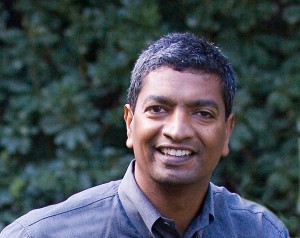
Oct 7, 2009 | Electric Vehicles, Entrepreneurship & Innovation, Fuel Cells, Green World, Sustainability, Transcripts
By Alison van Diggelen, host of Fresh Dialogues
SEE THE VIDEO INTERVIEW HERE – A FRESH DIALOGUES EXCLUSIVE Bloom Energy: Fuel Cell Technology
Bloom Energy: Affordability is Essential Video
Bloom Energy: Mission to Change the World Video
This is a transcript of Part One of my interview with Bloom Energy CEO, KR Sridhar about fuel cell technology, electric vehicles and the Bloom Energy mission. The interview was recorded on September 30, 2009 at the Bloom Energy headquarters in Silicon Valley, California. To listen to the interview and read the original post, click here. To read the transcript of Part Two of the interview – on fuel cell affordability, company timeline and the Bloom team- click here
Alison van Diggelen: KR, thank you for joining me today on Fresh Dialogues. First of all, I want to start with your background. You’ve been described by Fortune Magazine as one of the top five futurists. What is it about you that makes you able to tell – to invent – the future?
KR Sridhar: I’m not sure that I necessarily agree with that description, but… I’m not sure I’m deserving of that. But here is what I think: like any entrepreneur you don’t look at the world and take it for what it is, you always look for what it can be. And when you think that way, you have a different lens, a different perspective. You ask some very fundamental questions. Fundamental things that we take for granted but you say: why should it be that way?
And then you bring analogs from other worlds, other businesses, other practices and try to insert that into a new paradigm where there is really a market need, a disruptive element that you can bring forward. The examples would be in the green space if you’re thinking about… If you could do distributed computing from mainframe computing, and that changes the world; the fact that you could do distributed telephony – which is mobile phones from landline locked telephone – and you could change the world, then why couldn’t you do the same thing for energy?
Alison: So is that what you’re proposing at Bloom Energy?
KR: Yeah, yeah, yeah. That’s what we’re doing. So that’s an example of how you take…you really then invent something new. Distributed is a lot better than centralized because you’re empowering the people. It’s not some central authority that’s going to tell you when and how you can get your energy and at what cost and when can you have it. You give the power to the people; you empower them.
Alison: And talking of empowering the people, I want to talk about your motivations with Bloom Energy – for deciding: ‘OK, I’m going to leave NASA and I’m going to invent the future energy technology.’ What is your key motivator? Is it climate change, is it the world’s poor, is it the future for your children, or is it the huge market opportunity that you’ve talked a lot about?
KR: Well, it’s all of the above. But fundamentally the driver that makes you wake up in the morning and say: ‘This is more than a job, this is a mission. I’m committed to something that I’ll absolutely do.’ Where does that come from? It comes from something very fundamental. As human beings, as parents…any parent knows that anywhere in the world you go talk to any parent, it doesn’t matter what religion, country, economic, social background they have, if there’s one thing they have in common: they want a better life for their children than what they had. And I deeply believe that unless we solve this energy issue and not make it a zero sum game – where more and more of the population as the world’s population grows has to use a fixed amount of energy and so each one uses a lot less – then we cannot promise our future generations a better life than what we had.
But the big misunderstanding in my opinion is: people believe that more energy is more pollution, more unsustainable. There is nothing in science or technology, no physical laws, no chemical laws that say more energy and sustainability have to be at odds with one another.
Alison: So is Bloom Energy’s solution… is it non-polluting? Zero pollution?
KR: Yes and no, and I’ll explain what I mean by that. We have charted a road map. The road map simply says: today you have abundance of fossil energy which, no matter how you use it, will create some greenhouse gases. But then you ask the question: for the same amount of energy that I need to produce useful energy – electricity that I need to produce – how do I cause the least amount of pollution? So how can I take the fossil fuel and squeeze the maximum number of electrons out of it until the renewable fuels – in a sustainable way – become prevalent?
And the same technology that you used as a bridge to the future is also the future because it can use renewable fuels and give you zero net carbon. So it can do both. So that’s the practical way to get into something. As a baby you first learn to crawl, then to walk and then run. We want to just go from sitting down to running and I don’t think there’s that magic potion. So we’re building both the bridge as well as the future destination.
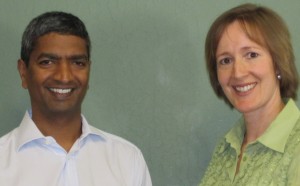 Alison: Right. You’re also good friends with Tom Friedman, and he’s quoted you in a recent column last year “We are thrivers. Thrivers are constantly looking for new opportunities to seize and lead and be number one. That is what America is about.” Can you explain that comment and whether you feel that with Bloom Energy that is part of your motivation: to lead and thrive and be number one?
Alison: Right. You’re also good friends with Tom Friedman, and he’s quoted you in a recent column last year “We are thrivers. Thrivers are constantly looking for new opportunities to seize and lead and be number one. That is what America is about.” Can you explain that comment and whether you feel that with Bloom Energy that is part of your motivation: to lead and thrive and be number one?
KR: Absolutely. We want to be number one simply because the mission of the company – and you’ll have seen it as you walked in on posters – we fundamentally want to change the world. This is a mission about changing the world because energy is a passport to a better living. For the rest of the world that does not have access to power, access to electricity, to give them that is empowering them to a better life. So if the solution works and you make it affordable and you can distribute it all over the world then definitely you have changed the world. So the motivation is that, if that’s the motivation and that’s your goal and you achieve that goal, clearly given the size of the energy market, it’s in trillions not in billions and given how many people you can impact with this kind of stuff, this has to be a prominent company. So, I would say being the number one corporation is an offshoot of achieving your larger mission which cannot be just counted in dollars and cents. So that’s what makes me feel really good about what I’m doing, because you can do good and make good and not have a conflict between those two.
Alison: And as far as saving the world from itself, what is your timetable for that? We’re living in fast paced Silicon Valley, people want to see results and I’m aware that you have a lot of pressure: when is it going to be revealed… the magic Bloom Box. What is your big picture timetable?
KR: Well, ask any entrepreneur, ask any missionary who wants to do something big, you’ll find one thing in common in all of them, there’s a sense of urgency. You feel like you need to do it do it faster than humanly possible and you somehow believe that and you push it. By having that sense of urgency you get there faster than anybody thinks is possible.
But this is a big scale issue. The size of this market, the size of what needs to get done. It’s larger than what people normally think about. This is not a microchip. These are huge devices, they need to be build in very large quantities, and if you take automotive, if you take anything else, its penetration and how long it takes to build the factories, the machines for factories. These things don’t happen over night. So it’s going to be faster than conventional energy people think it’s going to happen because they think in decades and centuries. It’s going to be slower than what the bits and bites people in Silicon Valley think because it’s not like software that you’re just going to write and then copy 800 times, or a million times over instantly, and distribute. It’s going to be a happy medium in between: so you’re looking at within a decade as opposed to within a century but you’re not talking about eight quarters. You are talking about longer than that.
Alison: And are you at the stage where you have the test boxes out there in the field?
KR: We have field trials going on. We’re still in a stealth mode so we really don’t get into the details of explaining that. But stay tuned and soon you’ll hear about it.
Alison: Great, and are the trials going on just in Silicon Valley or are you trying them out in India and all over the world?
KR: There have been reports written about our work in Tennessee that’s been going on for a couple of years. But again, the details of that are not something that we like to discuss at this point of time. Other than to say, we’re very optimistic about where it’s going and we feel very good about where it is, and it’ll get there.
Alison: And your funders are quite happy with progress?
KR: Yes
Alison: Good. That’s important.
KR: Yes
Alison: Tell me in simple terms what the Bloom Box does? I’ve read that it’s a chemical reaction in a box…can you explain a little more than that?
KR: The easier way to describe that is very simply: when you take a fuel, it doesn’t matter whether it’s a renewable fuel – like a biofuel, or biomass generated fuel or it is a fossil fuel – coal, oil, natural gas. A fuel is simply a substance that has in it chemical energy. You burn that in air, that’s combustion, and when you burn that you see the flame, that’s creates heat. So you’ve converted chemical energy to heat energy. That raises steam, the steam then goes into a big turbine that spins, so you’ve converted the heat energy to mechanical energy. Now, around that is a copper coil, called an alternator, converts the mechanical energy to electrical energy. So the way you convert this fuel to electrons on the other end, which is what you need, is going from chemical energy to thermal energy to mechanical energy to electrical energy.
When you do multiple forms of energy conversion it’s like starting with your dollar and going from airport to airport and changing your currency everywhere and paying your commissions.
Alison: You’re losing out
KR: At the end you end up with a lot less than a dollar, if you started with a dollar. In science terms, if you start with a dollar in this chemical, you end up with 30 to 40 cents by the time you get the electrons in the conventional way of converting the fuel.
Alison: And a lot of CO2
KR: Yeah, so if you need 40 cents worth of electricity you need to burn a hundred cents worth of fuel and create a hundred cents equal amount of CO2. And because this type of conversion only works well on a large scale – we’re talking 500 megawatts to a gigawatt size plant which can do from half a million to a million homes, that size big power plants. You put them very far away from where you live, and you have transmission distribution lines, that bring it hundreds of miles so you lose another 8 to 10 percent conversion. So what the Bloom Box does is it takes the chemical energy from the fuel and converts that to electrons with no in-between conversion. So you change your currency only once.
Alison: And how does it do that?
KR: It is an electro-chemical reaction. The simplest way for you to conveive of that is, it’s similar to your battery in your car, a lead acid battery. Everybody is familiar with that. The big difference between our box – which is a fuel cell – and that box – which is a battery – is a battery is only a storage device. If it’s a primary battery you use it once and you throw it away; if it’s a rechargable battery you keep doing the charge, recharge cycle.
A fuel cell is not a storage device, it’s a power generator, so you keep supplying the fuel in, as long as you’re supplying the fuel you’ll keep getting the electrons out without having to go through the charge recharge cycle. But a similar electro-chemical reaction, which is simply to say: you take a chemical and convert that to electricity with no in-between steps and most importantly without combustion, without fire. And so not only because of the high efficiency you get from the one step conversion do you have to burn less fuel and therefore less greenhouse emitting gases, but because there is no combustion, you eliminate all the combustion related polluting gases, like noxious gas from getting into the atmosphere.
Alison: And I also understand part of the Bloom box is splitting out the hydrogen?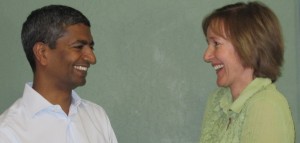
KR: That’s an option. People always ask, it’s electricity is it a fuel cell for the car? The answer is no. This is for stationary uses like buildings and houses. So then the question is, you have a big transportation infrastructure that requires fuel for that. Transportation can potentially go in two directions in the future: one is a hydrogen infrastructure for the car, the other one is an electrical infrastructure. We’re already getting a lot more comfortable with plug-in hybrids… which is right on the horizon.
Alison: Do you drive one?
KR: When the plug-in hybrid is there, I will drive one. I don’t like the hybrid as it is.
Alison: You don’t drive the Tesla?
KR: Unfortunately, I have children and I need a four seater…
Alison: Practical man
KR: …so I’m waiting for the Fisker which is a four seater
Alison: It’s imminent
KR: So, our device can either produce the electricity that will charge the car or provide you hydrogen if the transportation becomes hydrogen based. So we’ve sort of become the gas station for the transportation industry.
Alison: Your vision of the future with this KR…has been described as a refrigerator sized device.
KR: That’s the ultimate vision. How we get there I cannot describe right now.
Alison: So that’s maybe, what 20 years off…who knows?
KR: Silicon Valley time, ultimate is within a decade, right?
Alison: So it’s all within a decade.
KR: Right, right.
Alison: Well KR Sridhar, it’s been a pleasure. Thank you for joining me today on Fresh Dialogues.
KR: Thank you
This Fresh Dialogues interview was recorded at the Bloom Energy headquarters in Silicon Valley, California on September 30, 2009. To listen to the interview, click here

Sep 18, 2009 | Celebrities, China - what we can learn, Green World, Silicon Valley Events, Transcripts
 By Alison van Diggelen, host of Fresh Dialogues
By Alison van Diggelen, host of Fresh Dialogues
This is a transcript of my interview with Pulitzer Prize winning columnist and author Thomas Friedman. I caught up with Tom at Foothill College’s Celebrity Forum in Silicon Valley on September 10, 2009. To listen to interview highlights, click here
Alison van Diggelen: Tom, thank you very much for joining me today on Fresh Dialogues. I’d like to focus today on your book, ‘Hot, Flat, and Crowded.‘ Your premise is that energy technology (ET) is the next big thing and by focusing on it, American can get its groove back. Can you expand on what you mean by that?
Tom Friedman: I think that in a world that is becoming ‘hot’ – captured by climate change; ‘flat’ – rising middle classes all over the world from Russia to India, from Brazil to China; and ‘crowded’ – we’re going from 6.7 billion to 9.2 billion by 2050. In that kind of a world, demand for clean energy, clean fuel, energy efficiency is clearly going to explode. It’s clearly going to be the next great global industry. I know that as sure as I know that I’m sitting here at De Anza College, talking to you.
What I don’t know is who is going to lead that industry. Is it going to be America or China, India or Europe, Russia or Japan? What my book is really a call for is that America should lead that industry, because if it’s the next big thing, we need to be at the head of the line on the next big thing. And I think we get our groove back as a country by being big on the next big thing. Not only will it improve our standing economically but we’ll be seen by the rest of the world as working on the most important problem in the world.
Alison: Great. So Tom, you have two daughters, and you’ve written extensively about energy, political and economic security; and about the beauty of the planet, most recently from Botwsana. But what was your biggest motivation for writing this book?
Tom: My biggest motivation really was the concern about America. That…imagine if today Microsoft were a French company, Google was a Chinese company, IBM was a British Company, and Intel was a German company? What would our standard of living be like? What would our standard of living be like if we didn’t dominate the IT industry? What do you suppose our standard of living will be like if we don’t dominate the ET industry? If the next great solar company is Chinese? If the next great wind companies are Danish? If the next great battery companies are all Japanese?
Alison: And you’re advocating for government involvement. Why is it 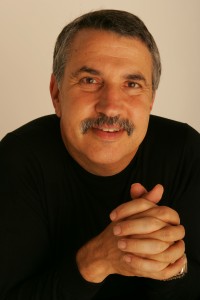 necessary to have government involvement to jumpstart this green economy? Why couldn’t it just happen?
necessary to have government involvement to jumpstart this green economy? Why couldn’t it just happen?
Tom: Because first of all you need more research. We haven’t really found the breakthrough scale technology; and research needs to be funded and that’s government’s role, to fund basic research…to push out the boundaries of physics, biology, chemistry and material science so we can have these really scale answers to clean energy and climate change.
Alison: But you’re talking about more than just research?
Tom: Yes, and government’s other role is to set prices, to create the regulations, incentives, the stimulus and the price signals that will drive innovation. That will stimulate both innovators to want to invest in these clean technologies and consumers to want to buy them.
Alison: And you’ve said one of your mottos is: ‘change your leaders not your light bulbs.’ Can you expand on that and talk about Obama? We now – after eight years – have an environmentally conscious president. Do you feel…
Tom: I mean leaders at all levels. Change your mayor, your governor, your senator and certainly your president… in ways that will put in those positions people who can write the rules, can set the taxes, can put in place the incentives. People who are commited to launching a kind of ecosystem of green innovation.
Alison: And do you feel that Obama has enough passion to do that and is putting in place the right legislation to do that?
Tom: I’m not sure yet. I think the book is still out on that. Although he did say he was reading my book (Hot, Flat, and Crowded) over his recent vacation at Martha’s Vineyard…
Alison: Any feedback from that yet?
Tom: I haven’t yet…no. Our sales went up though, so that was good.
Alison: Excellent. Well that’s a good endorsement. Great…
Now, you have a chapter in the book entitled China for a Day and you write in a recent column ‘China’s leaders understand that in a world of exploding population, demand for clean power and energy efficiency is going to soar. Beijing wants to make sure it owns that industry and is ordering the policies to do that.’ Do I detect a bit of China Envy there Tom?
 Tom: Um… Well. ..I…What you detect is the envy of someone who wants his own government to act democratically with the same effectiveness that China can do autocratically. And I think we could if we all pulled together and really focused on this project because this is a huge scale project. The government has to get it right; it has a huge role. And if government is not working; if it’s divided against itself – red states/ blue states – then we’re not going to get where we need to be.
Tom: Um… Well. ..I…What you detect is the envy of someone who wants his own government to act democratically with the same effectiveness that China can do autocratically. And I think we could if we all pulled together and really focused on this project because this is a huge scale project. The government has to get it right; it has a huge role. And if government is not working; if it’s divided against itself – red states/ blue states – then we’re not going to get where we need to be.
Alison: If Obama were to call you up tonight after your lecture and say, ‘I’ve read your book cover to cover, I want you as my Green Czar. ‘ What would you say to that?
Tom: I’d say, ‘I get my aggravation playing golf…’ (laughter)
But you know, I’m now 56 years old, if I wanted to go into government, I would have done so a long time ago. I’m a journalist, that’s what I do. I think it’s a noble craft. I love being a journalist; I love being a columnist at the New York Times. I have the best job in the world. There are plenty of people who can do those government jobs a lot better than we do. We have a terrific energy secretary, Steven Chu, Nobel Prize Winner, former head of Lawrence Berkeley Labs. I couldn’t hold a candle to him. I think Obama has the right people. the question is: can he pull his party and Congress together to really drive it forward.
Click here for the transcript of Fresh Dialogues with Tom Friedman Part Two on dealing with critics, Silicon Valley innovators and daiquiris with Maureen Dowd.
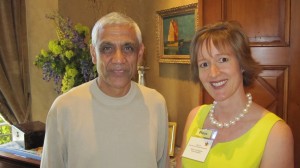
Jul 1, 2009 | Celebrities, Entrepreneurship & Innovation, Green World, Transcripts, Venture Capital & Finance
By Alison van Diggelen, host of Fresh Dialogues
This is a transcript of my interview with influential venture capitalist Vinod Khosla. The interview was recorded at the SD Forum Visionary Awards on June 25, 2009. To listen to the interview or read the summary post, click here
 Alison van Diggelen: I’m with Vinod Khosla, one of the Visionary Award winners for 2009. Vinod, firstly I want to congratulate you. How does it feel?
Alison van Diggelen: I’m with Vinod Khosla, one of the Visionary Award winners for 2009. Vinod, firstly I want to congratulate you. How does it feel?
Vinod Khosla: Thanks! Embarrassing…(laughter)
Alison: So this is not your cup of tea, to be the center of attention?
Vinod: Not really
Alison: So first of all, I want to ask you about your lead in clean tech. You were one of the first venture capitalists to see the opportunity in clean tech. Can you talk about where that motivation came from?
Vinod: Well, in 2000, I started looking for something new, something different and something large, and something amenable to technology disruption, and clean tech was one of those areas that popped up right away. So, right after I gave a talk about the optical bubble in 2000, when the stock market was still high, I said I should be doing something other than telecom, and that’s when I started looking and this is what popped up.
Alison: What was the first company that popped up, or was it just the sector in general?
Vinod: Well, in 2001 at Kleiner, we invested in Bloom Energy, and KR (Sridhar), who’s going to be introducing me tonight, was one of the first clean tech investments I pursued.
Alison: Is that looking good to you?
Vinod: Well, the company is very well funded, doing extremely well, and has been able to get great valuations in the market place, so I guess that’s a precursor to success. (laughter).
Alison: And where does this motivation come from? I mean, are you concerned about global warming first and foremost, are you concerned about the planet, or is it: here’s a great economic opportunity?
Vinod: Well, I am definitely concerned about global warming, and I am definitely concerned about how five billion people enjoy the lifestyle that 500 million people do today, out of the six and a half billion people we have and the nine billion we’re going to have. So it’s clearly that. But that itself creates an economic opportunity, so that concern about a crisis happening there creates the opportunity and then we muddle through and hope we can find the right answer.
Alison: And you’ve helped a lot of entrepreneurs along the way. I understand you’re very involved in the companies you invest in. Can you talk about how you’ve helped them?
 Vinod: Well, as our website says, we’re not in the venture capital business, we’re in the venture assistance business. That’s all I do, that’s what our website says, and frankly, that’s what I enjoy. I enjoy sort of being a coach and mentor to young entrepreneurs, and that to me is the most rewarding thing you can do. The fact that it’s a way to make money is almost incidental at this stage.
Vinod: Well, as our website says, we’re not in the venture capital business, we’re in the venture assistance business. That’s all I do, that’s what our website says, and frankly, that’s what I enjoy. I enjoy sort of being a coach and mentor to young entrepreneurs, and that to me is the most rewarding thing you can do. The fact that it’s a way to make money is almost incidental at this stage.
Alison: On your website, it also says that you had a dream to bring soy milk to India. What is your dream today?
Vinod: Well the dream clearly is to replace the four major emitters of carbon dioxide: oil, coal, steel and cement with much more carbon efficient technologies, and I think that’s the kind of new invention and innovation that we need to help the planet and create a whole new economic ecosystem. That’s the dream.
Alison: You were an early backer of biodiesel and it’s had some bad press because of deforestation etc.
Vinod: Actually, we never did invest in biodiesel. That is a misconception. We never did invest in any biodiesel company.
Alison: But you were a strong advocate of it I understand…no?
Vinod: No. I was always an advocate of cellulosic fuels, but people have used my name as if I’m supporting biodiesel, like you mentioned. I’m generally against all food based fuels.
Alison: I see, good to clarify that. And you are an investor in Ausra? Tell me about that investment and how that’s looking for the future.
Vinod: Well, it’s looking…You know, Ausra is pioneering a new kind of solar thermal technology for large power plants or additions to existing power plants and I like the fact that they can do a small add-on; a $10 Million add-on to an existing power plant, so you can reduce the amount of coal you burn or the amount of natural gas you burn. So that’s very neat about that technology and you can also build a 200 Megawatt power plant with the same technology, so I like that characteristic.
It’s early in the solar thermal race, but we’ll see how things go. We are optimistic.
Alison: And some people have already been talking about a clean energy bubble. Do you see that? Is that how you’d typify the market with this huge downturn in venture capital funding in the first quarter of this year.
Vinod: Well I was concerned about a clean energy bubble last year and though this economic downturn that’s happened is not good, it has helped slow down the bubble or pop it and I think we’ll hopefully have more reasonable development going forward.
Alison: So you feel the bubble has popped?
Vinod: Well, I wouldn’t say it was a bubble but it was in danger of becoming a bubble and I think that danger is lower, is reduced, is dissipated somewhat. But look, anytime greed starts to play these things pop up again, so it’s something we have to warn against.
I think it was in 2003 I warned against the nanotechnology bubble and that helped. I almost got sued for it.
Alison: Did you really?
Vinod: For saying nanotechnology was not right for public offerings and there was a couple of companies ready to go public. I think we have to avoid those bubbles because they’re not productive for anybody.
Alison: Yes. And what are your warnings today?
Vinod: Warnings about what?
Alison: About potential future bubbles?
Vinod: Well every rush turns into a bubble. It’s something we have to just…it happened with the railroads in the 1830s, it’s happened with almost every new technology and we just have to be cautious.
Alison: Right. And are you optimistic with the Obama administration in power now and their backing on clean energy?
Vinod: Yeah. I’m generally quite optimistic. I’m very optimistic that both we’ll find the technologies as well as the fact that we’ll have a huge impact.
Alison: Thank you very much Vinod.
This interview was recorded on June 25, 2009 at the SDForum Visionary Awards. To read the summary post or listen to the interview, click here







 Alison: Right. You’re also good friends with Tom Friedman, and he’s quoted you in a
Alison: Right. You’re also good friends with Tom Friedman, and he’s quoted you in a 
 necessary to have government involvement to jumpstart this green economy? Why couldn’t it just happen?
necessary to have government involvement to jumpstart this green economy? Why couldn’t it just happen?
 Vinod: Well, as our website says, we’re not in the venture capital business, we’re in the venture assistance business. That’s all I do, that’s what our website says, and frankly, that’s what I enjoy. I enjoy sort of being a coach and mentor to young entrepreneurs, and that to me is the most rewarding thing you can do. The fact that it’s a way to make money is almost incidental at this stage.
Vinod: Well, as our website says, we’re not in the venture capital business, we’re in the venture assistance business. That’s all I do, that’s what our website says, and frankly, that’s what I enjoy. I enjoy sort of being a coach and mentor to young entrepreneurs, and that to me is the most rewarding thing you can do. The fact that it’s a way to make money is almost incidental at this stage.

